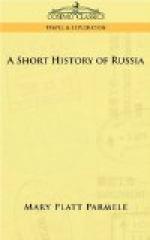It was a vast upheaval, a process in which the eternal purposes were “writ large”—too large to be read at the time. It was not intended that only the fertile Black Lands along the Dnieper, near to the civilizing center at Constantinople, should absorb the life currents. All of Russia was to be vitalized; the bleak North as well as the South; the zone of the forests as well as the fertile steppes. The instruments appointed to accomplish this great work were—the disorder consequent upon the reapportionment of the territory at the death of each sovereign—the fierce rivalries of ambitious Princes—and the barbaric encroachments to which the prevailing anarchy made the South the prey.
By the twelfth century the civil war had become distinctly a war between a new Russia of the forests and the old Russia of the fertile steppes. The cause of the North had a powerful leader in Andrew Bogoliubski. Andrew was the grandson of Monomakh and the son of Yuri (or George) Dolgoruki—both of whom were Grand Princes of extraordinary abilities and commanding qualities. In 1169 Andrew, who was then Prince of Suzdal, came with an immense army of followers; he marched against Kief. The “Mother of Russian Cities” was taken by assault, sacked and pillaged, and the Grand Principality ceased to exist. Russia was preparing to revolve around a new center in the Northeast; and with the new Grand Principality of Suzdal, far removed from Byzantine and Western civilizations, it looked like a return toward barbarism, but was in fact the circuitous road to progress. The life of the nation needed to be drawn to its extremities, and the ambitious Andrew, who assumed the title and authority of Grand Prince, had established a line which was destined to lead to the Czars of future Russia.
CHAPTER VI
GERMAN INVASION—MONGOL INVASION
The Principality of Novgorod had from a remote antiquity been the political center of Northern, as was Kief of Southern Russia. It was the Novgorodians who invited the Norse Princes to come and rule the land; and it was the Novgorodians who were their least submissive subjects. When one of the Grand Princes proposed to send his son, whom they did not want, to be their Prince, they replied: “Send him here if he has a spare head.” It was a fearless, proud republic, as patriotic and as quarrelsome as Florence, which it somewhat resembled. Their Prince was in reality a figurehead. He was considered essential to the dignity of the state, but his fortunes were in the hands of two political parties, of which he represented the party in the ascendant. Novgorod was a commercial city—its life was in its trade with the Orient and the Greek Empire, and like the Italian cities, its politics were swayed by economic interests. Those in trade with the East through the Volga desired a Prince from one of the great families about that Oriental artery in the Southeast; while those whose fortunes depended upon the Greeks preferred one from Kief or the principalities on the Dnieper. When one party fell, the Prince fell with it, and as the formula expressed it, they then “made him a reverence, and showed him the way out of Novgorod”—or else held him captive until his successor arrived.




